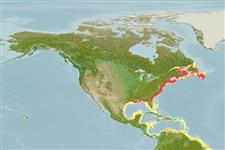Bivalvia |
Venerida |
Mactridae
Environment: milieu / climate zone / Mức độ sâu / distribution range
Sinh thái học
; Mức độ sâu 0 - 70 m (Tài liệu tham khảo 83435). Temperate, preferred 10°C (Tài liệu tham khảo 107945)
Western Atlantic Ocean.
Length at first maturity / Bộ gần gũi / Weight / Age
Chín muồi sinh dục: Lm ?, range 5 - 8.5 cm Max length : 20.0 cm SHL con đực/không giới tính; (Tài liệu tham khảo 7726); Tuổi cực đại được báo cáo: 31 các năm (Tài liệu tham khảo 8702)
Inhabits the shallow continental shelf (Ref. 106944). Suspension feeder (Ref. 78574).
Life cycle and mating behavior
Chín muồi sinh dục | Sự tái sinh sản | Đẻ trứng | Eggs | Sự sinh sản | Larvae
Members of the class Bivalvia are mostly gonochoric, some are protandric hermaphrodites. Life cycle: Embryos develop into free-swimming trocophore larvae, succeeded by the bivalve veliger, resembling a miniature clam.
Harvey-Clark, C. 1997 Eastern tidepool and reef: north-central Atlantic marinelife guide. Hancock House Publishers, 64pp. (Tài liệu tham khảo 7726)
IUCN Red List Status
(Tài liệu tham khảo 130435: Version 2025-1)
CITES status (Tài liệu tham khảo 108899)
Not Evaluated
CMS (Tài liệu tham khảo 116361)
Not Evaluated
Threat to humans
Human uses
Các nghề cá: Tính thương mại
FAO - Các nghề cá: landings, species profile | FishSource | Biển chung quanh ta
Các công cụ
Thêm thông tin
Sinh thái dinh dưỡngFood items (preys)
Thành phần thức ăn
Thành phần thức ăn
Các động vật ăn mồi
PhysiologyThành phần ô-xy
Human RelatedStamps, coins, misc.
Các nguồn internet
Estimates based on models
Preferred temperature
(Ref.
115969): 6.2 - 24.6, mean 23.5 (based on 274 cells).
Thích nghi nhanh
Trung bình, thời gian nhân đôi của chủng quần tối thiểu là 1.4 - 4.4 năm (K=0.23-0.36; tm=2; tmax=31).
Prior r = 0.53, 95% CL = 0.35 - 0.80, Based on 1 full stock assessment.
Fishing Vulnerability
Moderate to high vulnerability (50 of 100).
Climate Vulnerability
High vulnerability (60 of 100).
Nutrients : Calcium = 149 [71, 228] mg/100g; Iron = 8.53 [1.95, 15.11] mg/100g; Protein = 9.88 [8.64, 11.12] %; Omega3 = 0.313 [0.202, 0.423] g/100g; Selenium = 61 [50, 72] μg/100g; VitaminA = 0 μg/100g; Zinc = 2.04 [0.56, 3.51] mg/100g (wet weight); based on
nutrient studies.
